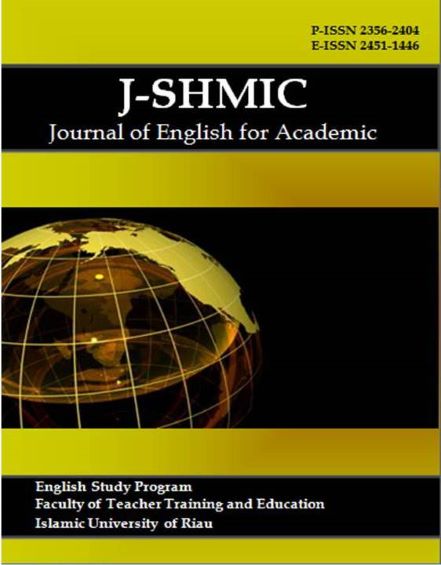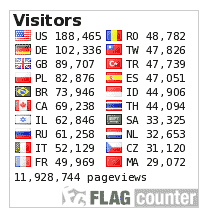Developing Needs Analysis of Critical Literacy Models for Teaching EFL Reading Class
Keywords:
Critical literacy, Critical literacy model, EFL Reading class, Needs analysisAbstract
Critical literacy models have been integrated into learning process in the English-speaking countries such as Australia, New Zealand, America, England, and some Europian countriea. As matter of fact, the critical literacy model used particularly for teaching reading classess is rarely found, especially the model which fits with the characteristics of EFL students. This study aims to explore the needs analysis development of critical literacy model for teaching reading in EFL reading class. This research adapted the Four D model which consists of four steps; defining, designing, developing, and disseminating. The results revealed the following. First, in defining, the researcher conducted preliminary study in English Language Education Study Program in three universities in Yogyakarta which was meant to analyze the students’ problems in the real setting. Second, the researcher created the prototype of the needs analysis in accordance with the results of the preliminary study. Third, the researcher validated the needs analysis to the two experts and conducted field testing to evaluate the validity of the questionnaire. The results of the needs analysis validation process show that the questionnaire is feasible (87.5 %) to assess the students’ needs of critical literacy model. Furthermore, in order to evaluate the practicality of the questionnaire, the researcher conducted a preliminary field testing to 27 students of English Language Education Study Program in a private university in Yogyakarta. In conclusion, the results of the needs analysis become the basis to develop a critical literacy model which is used for teaching EFL reading classes.
Downloads
References
Abednia, A. (2015). Practicing Critical Literacy in Second Language Reading. International Journal of Critical Pedagogy, 6(2), 77–94.
Asyura, F. (2021). Journal of English Language Teaching UNP JOURNAL Students’ Need Analysis on Critical Reading Learning Material at English Department of Universitas Negeri Padang Article History Abstract. Journal of English Language Teaching, 10(3), 462–474. https://doi.org/10.24036/jelt.v10i3.114339
Barnet, & Bedau. (2011). Critical Thinking, Reading, and wWriting : a Brief Guide to Argument (7th ed.; K. S. Henry, ed.). Retrieved from https://www.amazon.com/Critical-Thinking-Reading-Writing-Sylvan/dp/1457649977/
Basturkmen, H. (2010). Developing courses in English for specific purposes. https://doi.org/10.1057/9780230290518
Brown, J. D. (2009). Language Curriculum Development : Mistakes Were Made , Problems Faced , and Lessons Learned. Second Language Studies, 28(1), 85–105.
Cadiero-kaplan, K. (2002). Literacy Ideologies : Critically Engaging the Language Arts Curriculum. Language Arts, 79(5), 372–381.
Cahyaningrum, R., Lestari, W., & Supriyadi, S. (2022). Needs Analysis of Development of Critical Thinking Skills Assessment Instruments on Vocational School English Subjects. Journal of English Language Teaching and Linguistics, 7(1), 1. https://doi.org/10.21462/jeltl.v7i1.686
Ciardiello, A. V. (2004). Democracy ’ s young heroes : An instructional model of critical literacy practices. International Reading Association, 58(2), 138–147. https://doi.org/10.1598/RT.58.2.2
Elmarie & Blitzer. (2015). Engaging Higher Education Curricula - A Critical Citizenship Perspectives. Stellenboch: Sun Press.
Freire, P. (2005). Pedagogy of the Oppressed. New York: The Continuum International Publishing Group Inc.
Giroux, H. A. (1993). Literacy, Pedagogy, and the Politics of Difference. In Lankshear & Mc.Laren (Ed.), Critical Literacy: Politics, Praxis, and the Postmodernism (pp. 367–377). Retrieved from http://www.jstor.org/stable/25111937%0Ahttp://about.jstor.org/terms
Green, B. (1988). Subject-Specific Literacy and School Learning : A Focus on Writing. Australian Journal of Education, 32(2), 156–179.
Hutchinson, T., & Waters, A. (1987). English for Specific Purposes (6th ed.). https://doi.org/10.1017/cbo9780511667206.020
Indrasari. 2016. English for Specific Purposes: A Needs Analysis at Second Semester of IAIN Raden Intan in the Academic Year of 2015/2016.
Iwai, T., Kondo, K., Lim, D., Ray, G., Shimizu, H., & Brown, J. D. (1999). Japanese Language Needs Analysis. Second Language Teaching & Curriculum Center, (c), 1–87. Retrieved from http://hdl.handle.net/10125/8950
Janks, H. (2000). Domination , Access , Diversity and Design : A synthesis for critical literacy education. Educational Review, 52(2), 37–41. https://doi.org/10.1080/713664035
Janks, H. (2002). Critical Literacy : Beyond Reason. Australian Educational Researcher, 29(1), 7–27. https://doi.org/10.1007/BF03219767
Khanisah. (2002). Needs Analysis Dalam Pengembangan Kurikulum. Jurnal Mudarrisuda: Media Kajian Pendidikan Islam, 12(4), 837-850.
Lewison, M., Flint, A. S., & Sluys, K. Van. (2002). Taking on Critical Literacy: The Journey of Newcomers and Novices. Language Arts, 79(5), 382–392.
Luke. (2012). Critical Literacy : Foundational Notes. Theory into Practice, 51(4), 4–11. https://doi.org/10.1080/00405841.2012.636324
Luke, A., & Dooley, K. (2011). Critical Literacy and Second Language Learning. In E. Hinkel (Ed.), Handbook of Research in Second Language Teaching and Learning (pp. 1–17). Routledge.
Luke, & Freebody. (1999). Further Notes on the Four Resources Model. Retrieved from www.readingonline/research/lukefreebody.html
Montoya, S. (2018). Defining Literacy (Vol. 51). https://doi.org/10.1177/0022487100051004003
Morgan, B., & Ramanathan, V. (2005). Critical Literacies and Language Education: Global and Local Perspectives. Annual Review of Applied Linguistics, 25, 151–169.
Nusa, S. A., Jufrizal, & Amri, Z. (2020). Need Analysis on an Availability of Reading Comprehension Module Based on Scientific Approach for Tenth Grade Students: A Study at SMAN 7 Padang. 463(1), 96–103. https://doi.org/10.2991/assehr.k.200819.018
Paul, C. M. (2016). Integrating Critical Literacy in the Middle School Classroom. Middle Grades Review, 2(2), 1–6.
Pilgrim, J., & Martinez, E. (2013). Defining Literacy in the 21 st Century : A Guide to Terminology and Skills 21st Century Literacies Information Literacy. Texas Journal of Literacy Education, 1(1), 60–69.
Rambe, Y. (2017). Development of Critical Literacy Based-Critical Reading Model as a Learning Model. Journal of Indonesian Language Education and Literary, 2(1), 73–82.
Richards, J. C. (2001). Curriculum Development in Language Teaching. In Curriculum Development in Language Teaching. https://doi.org/10.1017/cbo9780511667220
Salam, S. (2017). Developing Needs Analysis Based-Reading Comprehension Learning Materials : A Study on the Indonesian Language Study Program Students. Advances in Language and Literary Studies, 8(4), 105–113.
Shor, I. (1999). What is Critical Literacy? Journal of Pedagogy, Pluralism, and Practice, 1(4), 1–32. Retrieved from http://www.lesley.edu/journal-pedagogy-pluralism-practice/ira-shor/critical-literacy/
Thiagarajan, S., & Semmel, D. (1974). Instructional Development for Training Teachers of Exceptional Children. Minnesota: Eric.
Published
How to Cite
Issue
Section
This is an open-access article distributed under the terms of the Creative Commons Attribution-ShareAlike 4.0 International License which permits unrestricted use, distribution, and reproduction in any medium. Users are allowed to read, download, copy, distribute, search, or link to full-text articles in this journal without asking by giving appropriate credit, providing a link to the license, and indicating if changes were made. All of the remixes, transform, or build upon the material must distribute the contributions under the same license as the original.











